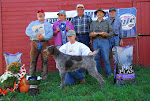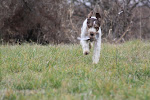How Not To Groom a GWP
Why? Why do people who own GWP's and show them think they have to make them look like Airedales? Grooming to clean them up, to remove dead coat, to present a nice, clean picture is one thing, but making them look like a whole different breed is another can of worms!
Why?
Why do our judges use these dogs and present them Best of Breed and or Winners ribbons when they don't look like German Wirehaired Pointers? Why do they choose to ignore our breed standard? It's stated in there pretty clearly that grooming to present a dog artificial in appearance is a huge no no!
Is anyone reading our breed standard?
Our breed standard clearly states under coat: The distinctive outer coat is straight, harsh, wiry and flat lying, and is from one to two inches in length. The outer coat is long enough to protect against the punishment of rough cover, but not so long as to hide the outline of the dog. On the lower legs the coat is shorter and between the toes it is of softer texture
Hmmm, not so long as to hide the outline of the dog, long enough to protect against the punishment of rough cover, flat lying. Very interesting. But what does that mean? How does the coat protect against the cover? Why is it flat lying?
Those Darn Pragmatic Germans!
The GWP is a do it all dog, water, field, forest. They are used extensively throughout the US as upland bird dogs and waterfowl retrievers. The cover they hunt ranges from the deserts of the southwest to the mountains of Vermont. They are expected to bust through the rough stuff, not shy away from thorns, stickers or ice.
A long stand off coat, whether on the body or especially the legs, chest and belly is nothing more than a magnet for dirt, mud and briars. If you have ever seen a dog full of cockle burrs it might help you understand why this type of coat is so detrimental to both the dogs working ability and to it’s health!
These burrs work their way under arm pits, between the toes and pads and if not removed quickly can cause serious harm to the skin. I’ve seen dog who ended up with horrible infections between their toes from missed cockleburs. The infection was so bad, we almost had to amputate a toe.
Excessive hair in the eyebrows and on the muzzle can cause a dog to become so full of burrs that their eyes and mouths become sealed shut.
Harsh, flat, tight fitting coats, especially on the legs, belly and chest shed these burrs with little work. The dog can actually pick them off if need be. And the owner doesn’t have to spend hours brushing and combing after a short hunt.
Excessive hair on the legs is also a danger for dogs working in the winter. Snow and ice will build up and could end a dogs day in the field. Ice balls between the toes cause sore feet, and can lead to infection.
Long or soft leg, chest and belly coat cannot protect the skin, it can only hinder the work of the dog! Excessive amounts of hair on the legs do indeed hide the true outline of the dog, that is unless the dog has perfectly round legs the width of a tree and thighs that would make Arnold proud!
When we overlook the purpose of the things our standard describe, we are overlooking what benefits the dog, and in the long run it’s owner. The Germans bred this type of coat because of it’s suitability for the work asked of the dogs, not because they thought it was pretty! A German Wirehair Pointer with leg hair so long that it can be sculptured into a beautiful round post is incorrect! It is dangerous for the dog, it is useless for the breed and frustrating for the owner.
But, it looks just like a GSP!
Then on the other hand we have some very short coated dogs that may at first glance appear to be German Shorthair Pointers. Our breed does indeed produce smooth coated dogs and a totally GSP type of coat is equally as incorrect as a too long coat, Correct, but shorter GWP coats will not feel like a GSP coat when you get your hand on it and in it. It will not feel smooth, it will have more depth and length, it will cover the body,legs and chest. These coats may not have much in the way of furnishings, but the texture will be there, there will be eyebrows and a beard.
Don’t over look these coats when looking at this breed. Breeders know these kind of coats could produce good coats down the road. Short, tight, coarse coats are utilitarian, wash and dry and usually protective. Whereas, the coats that are long will produce excessively long leg or chest coat down the road. Any good groomer will be able to trim that coat to make it appear not so long, but your hands can tell you all you need to know. Feel the texture, check for skin coverage, look to see if the outline is hidden.
How To Judge a coat
We need not to look for length, but rather for coverage, for depth, for thickness. Will those briars stick to this coat? Will those thorns rip skin? Are the hairs thick and strong? Or are they thin and whispy? Use your hands when judging coats, feel for texture, check the belly and chest, can you feel skin, can you see skin?
Is the Coat the most important thing on our dogs?
While coat is so terribly important to our breed it cannot be more important than soundness. A dog with an absolutely drop dead perfect coat that is flawed in it’s movement, that is unsound physically or mentally is just as useless to the hunter. We must strive for the package, the total animal that fits the bill in all ways.
But...... it's a Dog SHOW!
I understand it’s a dog show, with an emphasis on Show, but I always believed the purpose for a show was to choose breeding stock. A German Wirehaired Pointer should not look like a liver and white Airedale, or Giant Schnauzer. A dog with a coat such as this lacks breed type, lacks a correct German Wirehaired Pointer coat. When these types of coats are put up for our top honors, it encourages fad breeding, breeding to win in the show ring. But what good is producing pretty dogs that are useless for their intended purpose- hunting.
This is not a fancy breed, this is a down to earth, solid working dog whose history and heritage deserves to be upheld and honored. Breeders and owners who want to sculpt a breed, who have a need to have flowing coats should seek those breeds. Judges also need to honor our standard and attempt to learn what correct coat is.
This is not an easy breed to breed! We have to keep so many things in mind when choosing which dogs to breed. Athletic ability, bird sense, trainability, conformation, temperment, and then that proper coat. Keeping good, harsh, flat, and tight fitting coats has to be on our list, very high on our list because without it, it's just another long coated sporting dog. Please, let us not go the way of the Cockers and Setters!
















No comments:
Post a Comment